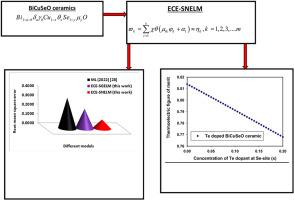当前位置:
X-MOL 学术
›
Solid State Sci.
›
论文详情
Our official English website, www.x-mol.net, welcomes your feedback! (Note: you will need to create a separate account there.)
Modeling thermoelectric figure of merit of BiCuSeO oxyselenide ceramic using extreme learning machine computational method
Solid State Sciences ( IF 3.5 ) Pub Date : 2024-02-14 , DOI: 10.1016/j.solidstatesciences.2024.107476 Fawaz Saad Alharbi
Solid State Sciences ( IF 3.5 ) Pub Date : 2024-02-14 , DOI: 10.1016/j.solidstatesciences.2024.107476 Fawaz Saad Alharbi

|
BiCuSeO ceramic is an eco-friendly oxyselenide thermoelectric material that provides alternative directions for refrigeration and power generation through direct conversion between electrical and thermal energy. Aside from environmental friendliness of BiCuSeO ceramic, relatively cheap input materials, low toxicity, good thermal and chemical stability are among the unique features that contribute significantly to wider applicability of this material for energy conversion. The energy conversion efficiency of un-doped and pristine BiCuSeO thermoelectric material is very low while enhancement of its energy conversion efficiency has attracted serious attention from both experimental and theoretical perspectives thorough modulation doping, dual-vacancies creation and dual doping among others. This work models the thermoelectric figure of merit (energy conversion efficiency, ECE) of doped BiCuSeO based ceramics using extreme learning machine (ELM) with ionic radii and elemental concentrations predictors. ECE-SNELM model with sine activation function performs better than ECE-SGELM with sigmoid activation function using root mean square error (RMSE), correlation coefficient (CC) and mean absolute error (MAE) performance evaluation and assessment parameters with improvement of 20.61 %, 5.51 % and 5.77 %, respectively when computed using testing samples of BiCuSeO-based ceramics. Comparison of the developed ECE-SNELM and ECE-SGELM model with the existing machine learning (ML) based model shows that ECE-SNELM and ECE-SGELM model respectively outperforms ML (2022) model with improvement of 70.89 % and 35.8 % using RMSE metric. The developed ECE-T-SNELM model that includes temperature among its descriptors further outperforms the existing ML based model with improvement of 39.39 % on the basis of RMSE metric. The predictions of the developed models agree well with the measured values. The developed ECE-SNELM was further employed for investigating the behavior of BiCuSeO-based ceramics after dopant incorporation. The precision demonstrated by the developed ECE-SNELM and ECE-SGELM models in determining thermoelectric figure of merit of BiCuSeO-based ceramics is highly commendable and meritorious in strengthen energy conversion efficiency of the ceramics for addressing the global challenges of energy crisis.
中文翻译:

使用极限学习机计算方法模拟 BiCuSeO 氧硒陶瓷的热电品质因数
BiCuSeO陶瓷是一种环保型氧硒热电材料,通过电能和热能的直接转换为制冷和发电提供了替代方向。除了 BiCuSeO 陶瓷的环境友好性之外,相对便宜的输入材料、低毒性、良好的热稳定性和化学稳定性等独特功能极大地促进了该材料在能量转换方面的更广泛应用。未掺杂的原始BiCuSeO热电材料的能量转换效率非常低,而通过调制掺杂、双空位创建和双掺杂等提高其能量转换效率已引起实验和理论的高度关注。这项工作使用带有离子半径和元素浓度预测器的极限学习机 (ELM) 对掺杂 BiCuSeO 基陶瓷的热电品质因数(能量转换效率,ECE)进行了建模。使用均方根误差(RMSE)、相关系数(CC)和平均绝对误差(MAE)性能评估和评估参数,具有正弦激活函数的ECE-SNELM模型比具有S形激活函数的ECE-SGELM表现更好,提高了20.61%,使用 BiCuSeO 基陶瓷测试样品计算时,分别为 5.51 % 和 5.77 %。将开发的 ECE-SNELM 和 ECE-SGELM 模型与现有的基于机器学习 (ML) 的模型进行比较表明,ECE-SNELM 和 ECE-SGELM 模型分别优于 ML (2022) 模型,使用 RMSE 指标分别提高了 70.89 % 和 35.8 % 。开发的 ECE-T-SNELM 模型在其描述符中包含温度,其性能进一步优于现有的基于 ML 的模型,在 RMSE 指标的基础上提高了 39.39%。所开发模型的预测与测量值非常吻合。开发的 ECE-SNELM 进一步用于研究掺入掺杂剂后 BiCuSeO 基陶瓷的行为。所开发的ECE-SNELM和ECE-SGELM模型在确定BiCuSeO基陶瓷的热电品质因数方面所表现出的精度是值得高度赞扬的,并且对于提高陶瓷的能量转换效率以应对全球能源危机的挑战具有重要意义。
更新日期:2024-02-14
中文翻译:

使用极限学习机计算方法模拟 BiCuSeO 氧硒陶瓷的热电品质因数
BiCuSeO陶瓷是一种环保型氧硒热电材料,通过电能和热能的直接转换为制冷和发电提供了替代方向。除了 BiCuSeO 陶瓷的环境友好性之外,相对便宜的输入材料、低毒性、良好的热稳定性和化学稳定性等独特功能极大地促进了该材料在能量转换方面的更广泛应用。未掺杂的原始BiCuSeO热电材料的能量转换效率非常低,而通过调制掺杂、双空位创建和双掺杂等提高其能量转换效率已引起实验和理论的高度关注。这项工作使用带有离子半径和元素浓度预测器的极限学习机 (ELM) 对掺杂 BiCuSeO 基陶瓷的热电品质因数(能量转换效率,ECE)进行了建模。使用均方根误差(RMSE)、相关系数(CC)和平均绝对误差(MAE)性能评估和评估参数,具有正弦激活函数的ECE-SNELM模型比具有S形激活函数的ECE-SGELM表现更好,提高了20.61%,使用 BiCuSeO 基陶瓷测试样品计算时,分别为 5.51 % 和 5.77 %。将开发的 ECE-SNELM 和 ECE-SGELM 模型与现有的基于机器学习 (ML) 的模型进行比较表明,ECE-SNELM 和 ECE-SGELM 模型分别优于 ML (2022) 模型,使用 RMSE 指标分别提高了 70.89 % 和 35.8 % 。开发的 ECE-T-SNELM 模型在其描述符中包含温度,其性能进一步优于现有的基于 ML 的模型,在 RMSE 指标的基础上提高了 39.39%。所开发模型的预测与测量值非常吻合。开发的 ECE-SNELM 进一步用于研究掺入掺杂剂后 BiCuSeO 基陶瓷的行为。所开发的ECE-SNELM和ECE-SGELM模型在确定BiCuSeO基陶瓷的热电品质因数方面所表现出的精度是值得高度赞扬的,并且对于提高陶瓷的能量转换效率以应对全球能源危机的挑战具有重要意义。



























 京公网安备 11010802027423号
京公网安备 11010802027423号